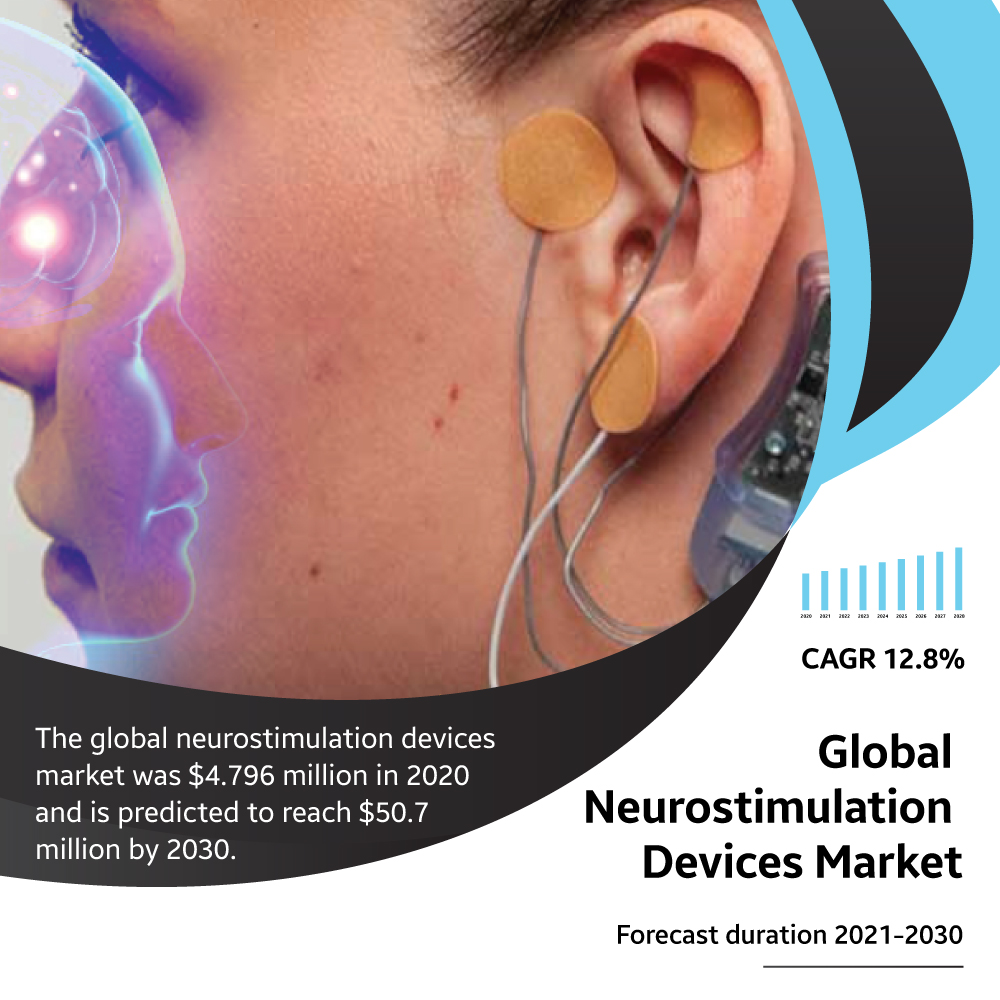The market for Neurostimulation devices will grow rapidly, with a CAGR of 12.8%, from its current value of $4.796 billion in 2021 to $50.7 billion by 2030.
Neurological illnesses like Parkinson’s disease, Alzheimer, epilepsy, & cerebrovascular diseases have an effect on the peripheral nervous system (PNS) & central nervous system (CNS) of the human body. For the treatment of neurological conditions such as Obsessive-Compulsive Disorder, ALS, etc., Neurostimulation technology is crucial. To assist the patients’ neurological activity, the electrodes inside the equipment emit electrical impulses. These devices come in both implantable and external varieties. The direct installation site of Neurostimulation devices is the brain, PNS, or CNS.
Market Dynamics
DRIVERS:
The total market for Neurostimulation devices is expected to grow as a result of more research being done on non-invasive brain stimulation treatments for age-related neurodegenerative diseases. Various brain stimulation (DBS) techniques have a significant impact on the market’s expansion. The demand for Neurostimulation devices is thought to be fuelled in large part by the incidence of Parkinson’s disease.
Hence Neurostimulation therapies are crucial for the treatment of various illnesses. Nearly 1 million Americans are thought to be affected by Parkinson’s disease, which is estimated to be diagnosed in at least 60k new cases annually. In light of the increasing prevalence of neurological diseases, there will likely soon be a rise in the need for Neurostimulation devices.
RESTRAINTS:
The insertion of Neurostimulation equipment into the body might cause adverse effects like allergic reaction or prickling and tingling of the skin, which are likely to limit the market’s growth.
OPPORTUNITIES
Modern products and technologies have been developed in response to the unmet needs of patients and surgeons in order to improve production efficiency and outcomes.
To improve the overall health of patients suffering from neurological disorders and provide improved & creative treatments to meet medical needs in this area, businesses have developed novel products and Technology, such as Neurostimulation devices. According to a study, 300 million disability-adjusted life years (DALYs), or 15.6% of all DALYs worldwide, will be caused by neurological illnesses in 2020. Boston Scientific unveiled the Primary Cell & Deep Brain Stimulation technology in January 2019 to treat the symptoms of Parkinson’s disease. In the future, a wide range of opportunities is anticipated to be supported by these systems.
Technology
o Spinal-Cord Stimulation
o Internal Neuromodulation
§ Vagus-Nerve Stimulation
§ Gastric-Electrical Stimulation
§ Deep-Brain Stimulation
§ Sacral-Nerve Stimulation
- External-Neuromodulation
§ TENS
§ TMS
§ RES
Application
- Chronic Pain
- Urinary & Faecal Incontinence
- Parkinson’s Disease
- Epilepsy
- Migraine
- Depression
- Tremor
- Others
Geography
North America
· USA
· Mexico
· Canada
· Rest of N.A.
Europe
· Suomi (Finland)
· Hungary
· Germany
· U.K.
· France
· Switzerland
· Turkey
· Netherlands
· Rest of Europe
Asia Pacific
· Japan
· China
· South Korea
· India
· Australia
· Rest of APAC
LAMEA
· Argentina
· Brazil
· Saudi Arabia
· Uruguay
· Rest of L.A.M.E.A.
For Technology, Internal Stimulation comprehensively dominated the market in 2021 with a significant share. The Spinal Cord section held the largest share of the market at around 51.55% & will likely continue its dominance over the prevised frame of time.
It is projected that technological advancement would drive this market’s expansion. Spinal-cord stimulators are used to treat non-malignant chronic neuropathic pain as they help to dull the pain by producing little nerve impulses regardless of the anatomy’s changes in the target area. Parkinson’s disease is one of many neurological disorders that is treated with deep brain stimulators. Because they are solely based on recent Technology, these devices are now considered experimental. The use of these devices to treat illnesses like refractory epilepsy, Alzheimer’s, trigeminal neuralgia, Tourette syndrome, cluster headaches, & movement difficulties linked to multiple sclerosis has not yet received FDA approval.
With a share of roughly 26.31% in terms of Applications, the Parkinson’s disease category largely dominated the whole market. It is among the most prevalent neurodegenerative brain disorders and is associated with severe mobility issues. According to GBD, or Global Burden Diseases, 6.23 million individuals globally had Parkinson’s disease in 2020. According to the Parkinson’s Foundation, over 60k Americans receive PD (Parkinson’s disease) diagnoses each year, with 4% of those diagnoses occurring before the age of 50. Therefore, the ongoing increase in PD cases is significantly boosting the global market growth.
North America produced about 60.0% of global revenue in 2021, and it is anticipated that it will maintain its supremacy throughout the forecast period. Government regulations that are too strict and an increasing requirement for FDA approval could impede the region’s development. Europe placed in second place to North America in terms of revenue share. Considering how quickly Eastern European countries are developing economically, this trend is expected to spread dramatically. This region has a higher production penetration rate because it is also simpler to gain a C.E. permission than an FDA clearance.
Key Companies
- Nevro Corp.
- Synapse Biomedical
- St. Jude Medical, Inc.
- Boston Scientific Corp.
- Cyberonics
- Neutronics Inc.
- Medtronic PLC
- ElectroCore Inc.
- Aleva Therapeutics SA.
- EndoStim Inc.
- NeuroSigma, Inc
- NeuroPace Inc.
I am a professional writer and blogger. I’m researching and writing about innovation, Entertainment, technology, business, and the latest digital marketing trends click here to go website. Follow my blog here & Visit my website here.



